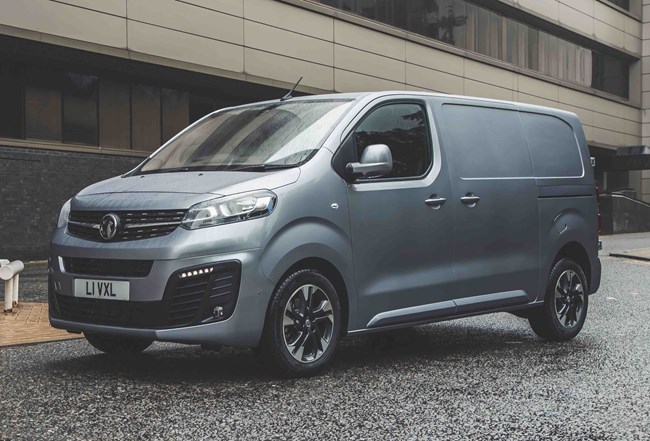- Toyota Hilux range gains new rally-inspired GR Sport II variant
- Remarketing: Pick of the bunch
- GA Commercial acquires first vans through Vanaways
- 'Luxury' tax on expensive pick-up trucks suggested
- ADVERTISEMENT FEATURE: Essential advice to avoid the van fleet ICE-berg
- ETRUX launches new Ford E-Transit Trizone
- Renault gives UK debut to Master E-Tech at CV Show
- Isuzu D-Max long-term test – Latest Report
- Isuzu D-Max V-Cross Steel Edition revealed
- IVOTY Report: Stellantis explores the hydrogen proposition
Buying a used... Vauxhall Vivaro (2019)
Date: Friday, October 27, 2023 | Author: Ian Shaw
The Vivaro sits uncomfortably in the sector – and so might you in the cabin.

If there is a single theme running through Vauxhall vans’ history it is one of identity crisis. This stems from the fact that other then its car-derived models ,they have all been re-badged versions or joint efforts. The Midi, was an Isuzu – likewise the Brava pick-up, which has carried both Vauxhall and Bedford names in its lifetime – whilst joint efforts with Renault sired the Movano (Renault Master) and Vivaro (Trafic) incarnations. The Renault-based Vivaro lasted for two generations but in 2019 – with the Luton brand now in Stellantis ownership – the vast majority of Vauxhall cars and its LCVs become re-badged PSA (Peugeot-Citroën) products
Essentially here is a Citroën Dispatch / Peugeot Expert, but trim and equipment levels vary slightly for a veneer of difference. Sharing the same 3,275mm wheelbase, the overall lengths are 5.0m and 5.4m, respectively in L1 and L2 designations with the latter achieved by the cost-effective if somewhat ungainly rear overhang extension. The other externals being 1.92m in the beam and standing 1.95m high. All that creates some 2.0m to 2.3m of load length in L1 and L2 increasing to 2.5m and 2.8m with the optional FlexCargo folding bulkhead. Internal width is 1,630mm at most pinching to 1,260mm between the arches, with 1,400mm of headroom equating to 5.3m3 or 6.1m3 and FlexCargo increasing that to 5.8m3 and 6.5m3 respectively. Depending upon trim, expect 975–1,450kg of payload and towing weights range from 1,800kgs with the 1.5-litre diesel to a whopping 2,500kgs for the 2.0-litre manual.
For such a generously wide van, the cab feels cramped and somewhat claustrophobic. There’s decent storage all around but somehow very little elbow room. However that’s not the worst of it, the offset steering wheel and badly aligned pedals belong in a van from the 1960s.
For a company with such combined LCV experience – Stellantis owns Fiat too – it’s really poor, although it may just affect RHD markets. Standard equipment is thankfully a better story. Even basic models have twin side loading doors, DAB radio, Bluetooth, electric windows, mirrors and locking, whilst the Sportive adds a whole raft of kit. This includes a 7in touchscreen infotainment system with Apple CarPlay and Android Auto, air-conditioning, rear parking sensors, the FlexCargo load-through bulkhead, six-way adjustable driver’s seat (pity it cannot move sideways!) with centre armrest and dual passenger bench seat with fold flat centre. Outside there’s metallic paint, body-coloured bumpers and door mirrors, front fog lights, LED daytime running lights and automatic lights and wipers.
The Elite version cosmetically only adds alloy wheels but brings in a huge suite of safety and driver assistance tech. The engine choice is much simpler. For light duty city work it’s the 1.5-litre 100hp unit, for anything else it’s the 2.0-litre; in 145hp guise for motorway work or 180hp if always fully-laden and that great 2.5t towing capacity.
The auto box is good, too, available with 2.0-litre engines.
Quality is decent – if not up to Transit Custom or VW Transporter level – and the equipment mix favours the Vivaro over its French-badged siblings. A decent van – if you can get comfy!
Plus points
1) Two-litre engine
2) Excellent payload
3) Great towing capacity
Minus points
1) Woeful driving position
2) Sub-Elite trims lack safety kit
3) Little to differentiate it from PSA models
Second-hand buys
|
Version |
Plate |
Year |
Mileage |
Price ex.VAT |
|
1.5 L2H1 Dynamic |
69 |
2020 |
98,000 |
£13,795 |
|
1.5 L2H1 Dynamic |
20 |
2020 |
66,400 |
£14,790 |
|
2.0 L1H1 Sportive |
21 |
2021 |
24,700 |
£21,995 |
|
2.0 L1H1Elite |
22 |
2022 |
5,600 |
£25,995 |
|
2.0 L2H1Elite |
23 |
2023 |
25 (ex demo) |
£27,995 |
View The WhatVan Digital Edition


